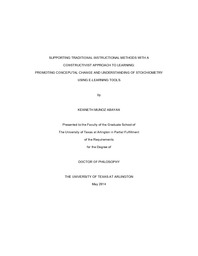| dc.description.abstract | Stoichiometry is a fundamental topic in chemistry that measures a quantifiable relationship between atoms, molecules, etc. Stoichiometry is usually taught using expository teaching methods. Students are passively given information, in the hopes they will retain the transmission of information to be able to solve stoichiometry problems masterfully. Cognitive science research has shown that this kind of instructional teaching method is not very effecting in meaningful learning practice. Instead, students must take ownership of their learning. The students need to actively construct their own knowledge by receiving, interpreting, integrating and reorganizing that information into their own mental schemas. In the absence of active learning practices, tools must be created in such a way to be able to scaffold difficult problems by encoding opportunities necessary to make the construction of knowledge memorable, thereby creating a usable knowledge base. Using an online e-learning tool and its potential to create a dynamic and interactive learning environment may facilitate the learning of stoichiometry.The study entailed requests from volunteer students, IRB consent form, a baseline questionnaire, random assignment of treatment, pre- and post- test assessment, and post assessment survey. These activities were given online. A stoichiometry-based assessment was given in a proctored examination at the University of Texas at Arlington (UTA) campus. The volunteer students who took part in these studies were at least 18 of age and were enrolled in General Chemistry 1441, at the University of Texas at Arlington. Each participant gave their informed consent to use their data in the following study. Students were randomly assigned to one of 4 treatments groups based on teaching methodology, (Dimensional Analysis, Operational Method, Ratios and Proportions) and a control group who just received instruction through lecture only. In this study, an e-learning tool was created to demonstrate several methodologies, on how to solve stoichiometry, which are all supported by chemical education research. Comparisons of student performance based on pre- and post-test assessment, and a stoichiometry-based examination was done to determine if the information provided within the e-learning tool yielded greater learning outcomes compared to the students in the absence of scaffold learning material. The e-learning tool was created to help scaffold the problem solving process necessary to help students (N=394) solve stoichiometry problems. Therein the study investigated possible predictors for success on a stoichiometry based examination, students' conceptual understanding of solving stoichiometry problems, and their explanation of reasoning. It was found that the way the student answered a given stoichiometry question (i.e. whether the student used dimensional analysis, operational method or any other process) was not statistically relevant (p=0.05). More importantly, if the students were able to describe their thought process clearly, these students scored significantly higher on stoichiometry test (mean 84, p<0.05). This finding has major implications in teaching the topic, as lecturers tend to stress and focus on the method rather than the process on how to solve stoichiometry problems. It is well known that many metal complexes cause oxidative damage to DNA in
the presence of oxygen through Fenton like chemistry via the formation of reactive
oxygen species (ROS). The MacDonnell group has develop two novel ruthenium
polypyridyl complexes, the dinuclear complex, (phen)2RuII tatppR(phen)2RuII 4+ and the
mononuclear analogue (phen)2RuII tatpp 2+ cause damage to DNA in the presence of a
reducing agent like glutathione (GSH). Although these complexes require oxygen to
damage DNA, it has been shown that the oxidative damage caused by these complexes
is enhanced under hypoxic conditions. It also has been shown, through the use of radical
scavengers and EPR data, that the radical produced is an organic radical and not an
ROS. This paper explores the possibility that a 2 H+/ 1 e- process is necessary for this
reaction to occur. | en_US |


